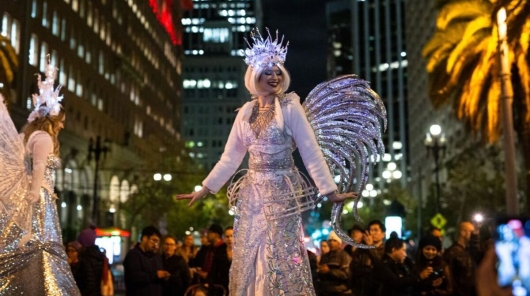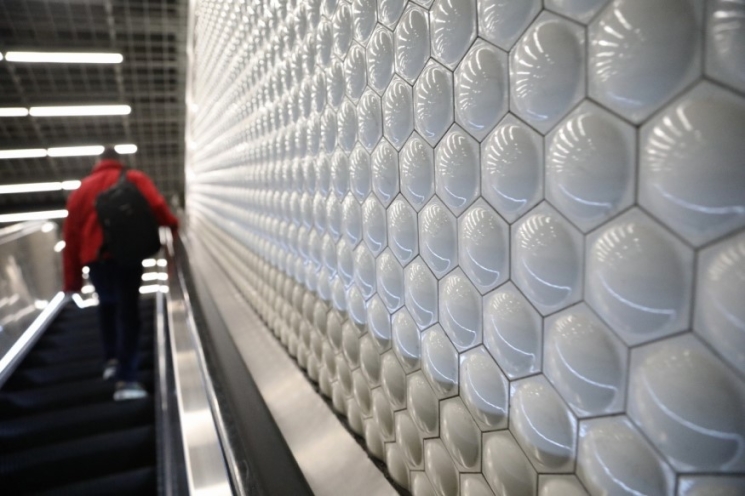
The story of BART’s iconic bubble tiles
BART's bubble tiles are seen on a wall at Powell St. Station.
There’s just something about BART’s bubble tiles.
Long a fascination for riders, the white hexagonal tiles with a domed center have been capturing the Bay Area’s attention since the opening of BART’s Powell St. and Montgomery St. stations in 1973. The tiles were even incorporated into the new ceiling artwork, “Elysium” by artist Stephen Galloway, at Powell St. Station.
“There’s nothing like them,” Galloway said of the tiles.
Piecing together the story of the bubbles tiles is a bit like constructing a mosaic of shards collected through the years. A tidbit or factoid comes from here, another from here, and another from here.
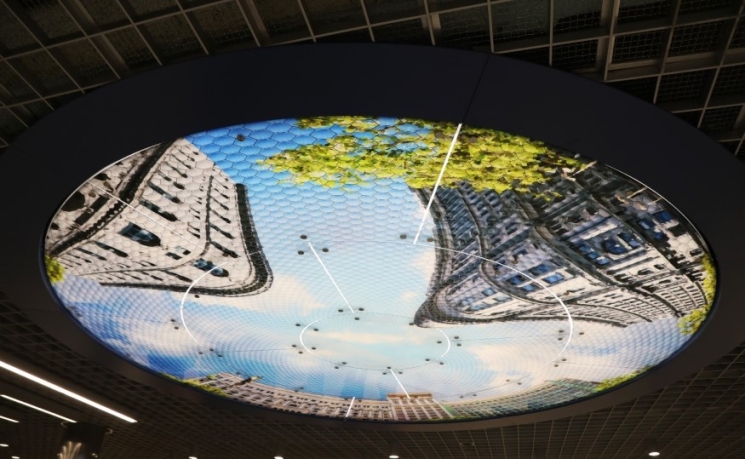 A bubble tile motif is seen overlaying Stephen Galloway’s “Elysium” at Powell St. Station.
A bubble tile motif is seen overlaying Stephen Galloway’s “Elysium” at Powell St. Station.
A good place to start is by looking at the original architecture plans for Powell St. and Montgomery St. stations, which were designed by architecture firm Skidmore, Owings & Merrill (SOM). The plans, however, stick to design details and fail to mention the (soon-to-be) famous tiles.
There is however a document that provides illumination: SFBARTD Architectural Standards, published in June 1965. Under the section “Materials and Finishes,” the document outlines the “basic requirements and criteria” for finish materials used in all public areas of the BART system “to the end that the quality level and maintenance requirements of such materials will be consistent throughout.”
The “basic goals” for BART’s finish materials include safety, durability, ease of maintenance, and aesthetic qualities, while the section “General Criteria” offers more granular requirements for the finish materials, such as surface, color, texture, unit size, joints, cost, and availability. Listed under “Wall Materials,” you will find a section that names “glazed ceramic tile” as an acceptable “unit material.” (The signature bubble tiles are, in fact, glazed ceramic tiles.)
The document provides one additional hint as to how the bubble tiles came to be: “It is intended that Project Architects shall have the freedom to propose materials best suited to the environment and design of the individual stations, provided that they meet the Performance Standards specified in this Section.”
BART District Architect Tian Feng noted that Powell St. and Montgomery St. stations are “premium urban stations serving riders from all walks of life and all over the world.”
“The architect would say [of the bubble tiles], this is a premium material for a premium station,” Feng said.
 A page from the 1970 architectural finish drawings for Powell St. Station that detail the bubble tiles.
A page from the 1970 architectural finish drawings for Powell St. Station that detail the bubble tiles.
But why do Montgomery St. and Powell St. use the tiles when no other stations do? BART Principal Architect David Pultz has an answer.
“The stations were often designed in pairs by the same architect,” Pultz said, citing similarly looking stations such as Glen Park and Balboa Park, Rockridge and MacArthur, and – you guessed it – Powell St. and Montgomery St. Indeed, the latter two stations were both designed by SOM.
We can glean insight from outside sources on these mysterious tiles, as well. For one, we must ask, why would a subway station use tile in the first place? The answer can be found by going back in time, to the planning and construction of New York City’s earliest subway stations.
According to Why Tile, a joint initiative of tile stakeholders with “the common goal of simply providing education and information about tile,” when New York was designing its subway stations, attention to quality was paramount.
“They chose to use ceramic tile in their designs in part because of its durability and easy cleaning,” an article about City Hall Station explains. “Hygiene was a major concern during the Victorian era and would be especially important to make passengers feel safe and comfortable underground — something that the white tiles’ glazed surface, which reflected light, was also intended to help with.”
Hannah Simonson, the President of Docomomo US/NOCA, an organization that aims to increase public awareness of the Modern Movement, thinks BART’s bubble tiles may have been chosen because they were “utilitarian and simple.”00
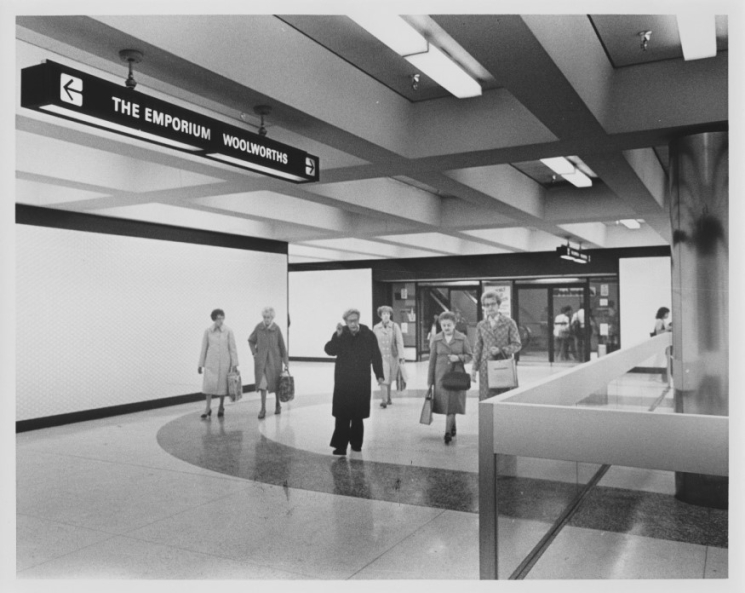 A historic photo of Powell St. Station shows BART’s beloved bubble tiles.
A historic photo of Powell St. Station shows BART’s beloved bubble tiles.
“Subway tiles in general (including the more common flat rectangular ones) are easy to clean,” Simonson said.
We understand why BART’s architects would use tile, but why domed – or bubble – tile? Again, the answer seems to be one of practicality and utility. In a 1983 San Francisco Examiner article about the city’s new Muni Metro system, the author mentions the bubble tiles by the fourth paragraph. (You can find white hexagonal tiles in the Muni portion of Powell St. and Montgomery St. stations.)
Per the article, an unnamed “caped commuter” entered Powell St. Station by way of the Stockton Street entrance when he “took note of a major achievement of the Muni/BART subway stations: virtually no graffiti. The bubble-shaped tiles on station walls were a clever innovation since vandals apparently have difficulty writing on them.”
Tile expert Joe Taylor with the Heritage Tile Foundation believes that the bubble tiles were likely installed as a means of discouraging graffiti in the shiny new stations. And by current accounts, the method has proven successful. On a recent visit to Powell St. Station, the bubble-tiled walls were altogether free of scribbles.
Taylor believes the tiles were produced in the early 1970s by Interpace Corporation at either its factory in Lincoln, Calif., or plant in Glendale, Calif. Interpace was dissolved in 1984. Taylor also said Tile Heritage was gifted a box of these Interpace bubble tiles, and at least one of the tiles in the collection was stamped with “2/11/72.” He even checked the “porousness” of the tiles by licking one himself.
Riley Doty, a master tiler based in San Francisco, has even more tales to tell of the tiles. He said he’s especially enamored with the precision of their installation.
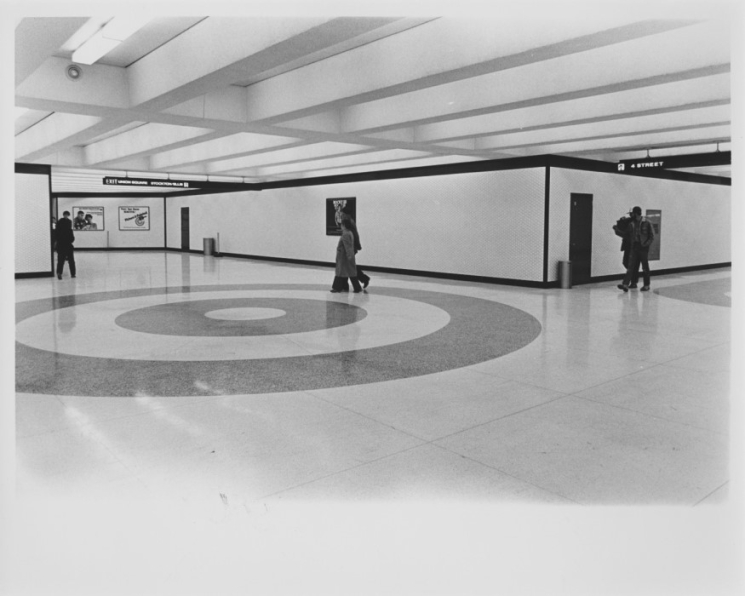 The bubble tiles at Powell St. Station are visible on the walls in this historic photo.
The bubble tiles at Powell St. Station are visible on the walls in this historic photo.
“Looking at the results, I’ve always felt that the tilework at BART represents the highest level of what the trade offered at that point in history,” Doty said.
Doty remembers an instance from his years as an apprentice when a journeyman told him about the big BART tile project.
“[The journeyman] said the marching orders were clear and simple: ‘Put your best men on it. No screwups. Everybody makes money,’” Doty recalled.
The BART tile installation “represents an exceptionally fine installation of its period,” Doty said.
“If excellent largescale projects were done today, the main material would probably be large-format porcelain (rather than ceramic) units,” Doty said. “Not to say one is better than the other, but the BART installations represent period pieces that display the traditional tile setting of their era.”
To install the tiles at the stations, workers had to lay out the tile scheme with water levels and chalk lines, as lasers were not yet used for this purpose.
“Only a skilled, experienced mechanic could stay on top of the whole thing,” Doty explained, “including floating walls in multiple sections to produce one unified plane.”
Doty also noted that hexagonal tiles, or hex tiles, have a long history in design and architecture. The tile shape was popular in bathrooms, from about 1890 to WWI, to “such an extent as to become painfully boring,” Doty said, adding that he’s never seen the tiles used “anywhere else, ever.”
There is one place, to our knowledge, that the bubble tiles have been used beyond bathrooms and BART stations. According to a 2013 article in Houzz, a San Francisco couple loved BART’s bubble tiles so much, they found a similar tile style and incorporated them into a kitchen backsplash.
“One day I actually took notice [of the tiles at BART stations] and thought, ‘Wow, this would be awesome to have in the kitchen,” the article quotes Katie Boudier as saying. “I became pretty obsessed with it.”
BART, recognizing the outsize influence of the bubble tiles on the public consciousness, has endeavored to maintain the tiles in Powell St. and Montgomery St., but has had to, in some cases, get creative.
 The BART Police Station at Powell St. with bubble-tile wallpaper.
The BART Police Station at Powell St. with bubble-tile wallpaper.
Feng, the District Architect, recalled the construction of the BART Police station at Powell St in 2004/2005. The project had a small budget that could not accommodate the inclusion of new bubble tiles. So, Feng had another idea: “I said, ‘Okay, take a photograph of the tiles with the exact dimensions, and we’ll print a wallpaper for the BPD station wall.”
“It proved very effective,” Feng noted. “Few people even notice it’s wallpaper.”
When BART began modernization efforts for Powell St. Station, wallpaper just wouldn’t do. While BART did have extra, original bubble tiles in storage, there weren’t enough for anything more substantial than a repair.
For Wahid Amiri, the BART Project Manager who oversaw the modernization project, the bubble tiles represent “history.”
“We wanted to keep the continuity; they’ve become a part of the environment,” Amiri said. “They are an art piece in themselves.”
Because the original tile manufacturer closed, Amiri and his team decided to recreate the iconic tiles from scratch. They joined forces with a tile manufacturer and supplier, North Prairie Tileworks, and set forth.
“It did take us quite a bit of back and forth,” Amiri said. Matching the original color was the greatest challenge, as “even a slight variance in hue would show.”
Today, Amiri is proud to say that visitors to Powell St. Station won’t be able to tell the difference between the original and new tiles, unless they’re wielding “a magnifying glass.”
And there’s more good news for lovers of the bubble tile: Amiri ordered a surplus from the manufacturer. The BART bubble tile will, fortunately for its fans, live on.


